Biology (Elective) Rhizopus stolonifer – Common bread mold
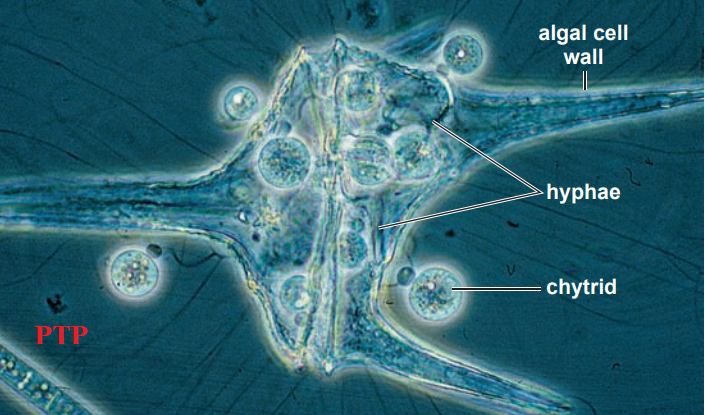
RHIZOPUS (Rhizopus stolonifer) – Common bread mold
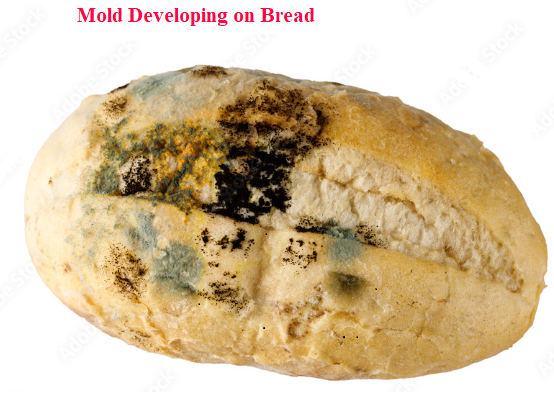
Biological classification
Kingdom fungi
Reasons:
- They lack chlorophyll.
- Presence of hyphae which form mycelium
- They possess no true roots, stems and leaves
- Presence of cell wall made of chitin
- They are eukaryotic.
Phylum Zygomycota
Reasons:
- Possess gametangia which form zygospores.
- Presence of sporangium on sporangiophore.
- They are non-septate (their hyphae have no cross wall)
Habitat of Rhizopus stolonifer
- Moist bread
- Fermented kenkey.
- Rotten fruits and vegetables.
Structure of Rhizopus.
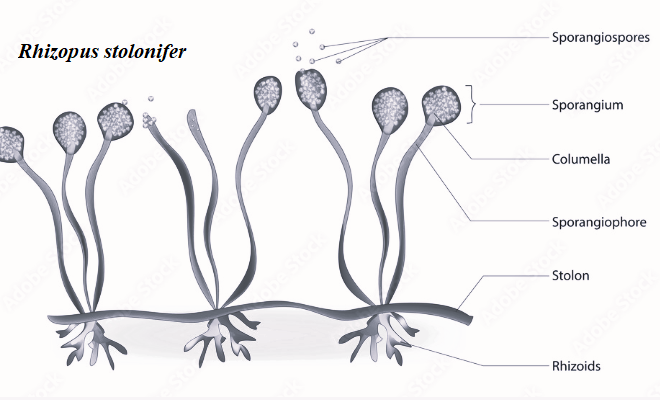
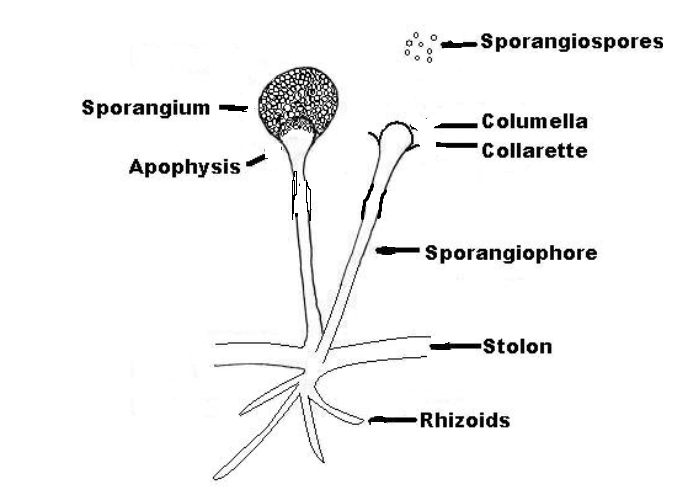
The basic unit of Rhizopus is a microscopic thread-like structure called hypha.
The hyphae form an interwoven mass called mycelium (plural – mycelia).
Mycelium is the vegetative part of a fungus.
There are three main parts of the mycelium.
These are stolon, rhizoid and sporangiophore.
Stolon: This is a hypha that grows horizontally on the substrate
Rhizoid: This is a root-like hypha which is more branched than the other two types and grows from the stolon into the substrate.
- Rhizoid supports the fungus onto the substrate
- Secretes digestive enzymes
- Also, absorbs nutrients from the substrate.
Sporangiophore – This is an upright and unbranched hypha.
- It bears a swollen end called sporangium (plural =sporangia).
- Sporangia contain spores which are used in asexual reproduction.
Adaptive features of Rhizopus.
- Presence of sporangia which produce spores and protect them.
- Possesses sporangiophore which holds sporangia in position for dispersal of spores.
- Mycelium for vegetative growth.
- Also, spores are present for asexual reproduction.
- Presence of rhizoid for absorption of nutrients, anchorage and secretion of digestive enzymes.
- Presence of stolon for vegetative growth.
Mode of reproduction.
- Sexual reproduction by gametangia, which is a means of surviving adverse conditions.
- Asexual reproduction by spores in the sporangia.
Asexual reproduction in Rhizopus
- Asexual reproduction is by spores produced in the sporangium.
- In this process, a vertical hypha called sporangiophore
- The tip of the sporangiophore then enlarges into a sporangium.
- During the development of sporangium, dense cytoplasm containing several nuclei migrate to the periphery and develop into spores.
- The central portion contains a vacuole and is called the columella.
- Young sporangium is white or colourless.
- As sporangium matures, it becomes black and dries.
- The walls crack and release the dry powdery spores by air.
- Spores land on suitable substrates such as moist bread or fermented kenkey.
- Under favourable conditions such as the presence of moisture, a spore develops into a hyphae and a hyphae later develops into mycelium
Sexual reproduction
- Sexual reproduction in Rhizopus is called conjugation.
- Conjugation in Rhizopus involves the union of two different strains of mycelia (plus (+) and minus (-) strains).
- When the hyphae of (+) and (-): strains come together, they develop short swollen side branches called progametangia (progametangium which is singular)
- When the progametangia develop and meet a cross-wall, it develops between their tips.
- Each tip then develops into a gametangium (plural – gametangia) with a stalk called Suspensor.
- Each gametangium contains several haploid nuclei.
- Later, the cross-wall breaks down.
- The gametangia fuse and their contents mix.
- Their nuclei pair up as + and – which fuse to form many diploid nuclei.
- The fused gametangia becomes a zygospore.
- The zygospore grows and develops a thick black and resistant wall, after which it is disconnected from the parent hyphae.
- The zygospore can withstand adverse conditions.
- In favourable conditions, the zygospore undergoes meiosis, germinates and develops into a haploid hypha which is either (+) or (-).
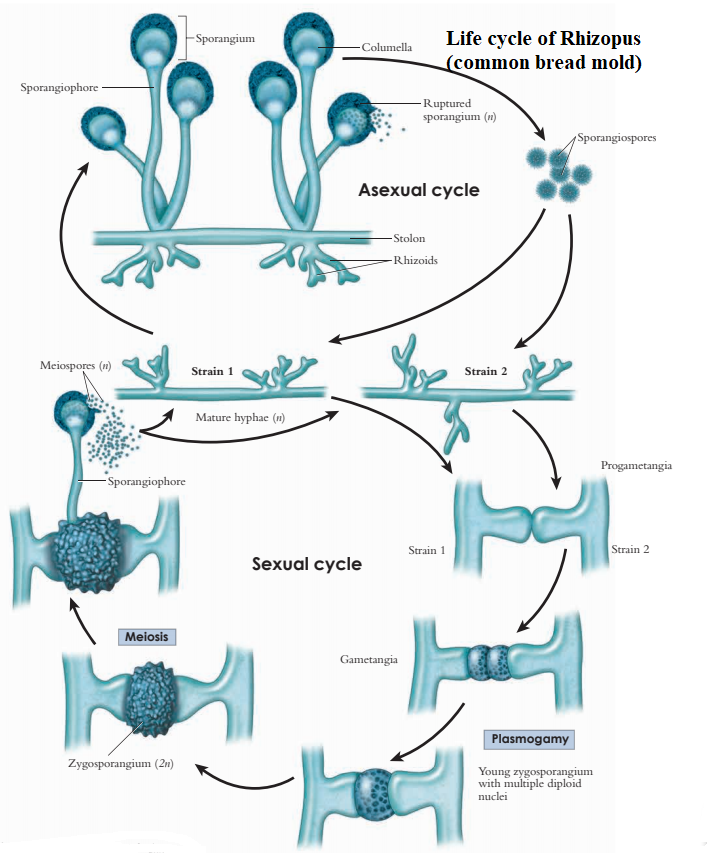
Factors that enhance growth in Rhizopus.
- Suitable temperature for enzymatic activities.
- Moisture to activate enzymes to digest food.
- Presence of dead organic matter/nutrients for the growth of mycelium.
Adaptations of Rhizopus to dispersal.
- Spores are light in weight.
- Numerous spores to ensure survival.
- Thickened walls of spores for protection against unfavourable environmental conditions.
Mode of nutrition.
- Rhizopus has no chlorophyll and undergoes a saprophytic mode of nutrition.
- The hyphae penetrate the substrate
- Secrete digestive enzymes on the food to digest it extracellularly converting it into a soluble form.
- The end products are absorbed into hyphae by diffusion.
Economic importance of Rhizopus
- Contaminates food or food spoilage
- Causes decay or decomposition
- Improves soil fertility
- Causes diseases in plants.
- Natural recycling of wastes from the ecosystem.
Ecological importance
- Decomposition
- Natural recycling
Questions for revision.
- State four parts of Rhizopus (bread mold) and their functions.
- Name two habitats of Rhizopus.
- Explain briefly how Rhizopus can be cultured in the laboratory.
- Describe how Rhizopus obtain food.
- State the effect of the presence of the following on Rhizopus.
-
- High humidity
- Temperature
- Dead organic matter
- Briefly explain how Rhizopus recycle the soil nutrient by decomposition.






The site’s user-friendly interface made the customization process enjoyable and hassle-free and a seamless shopping experience makes com the ideal choice for anyone seeking a high-quality,